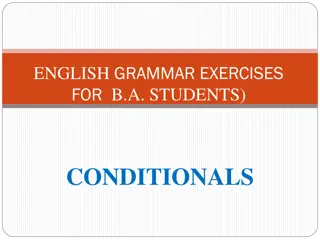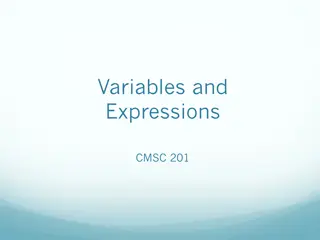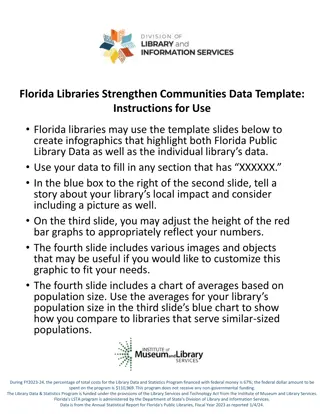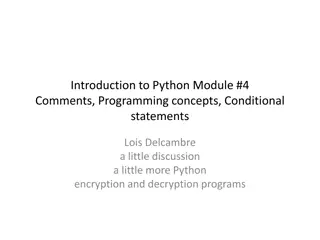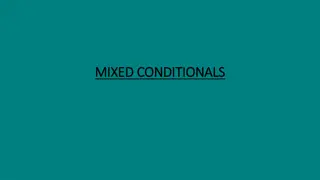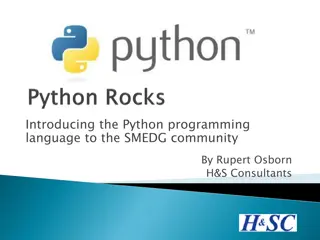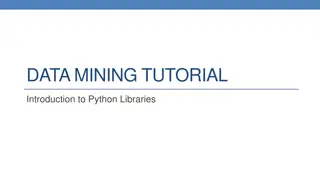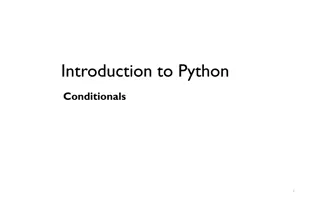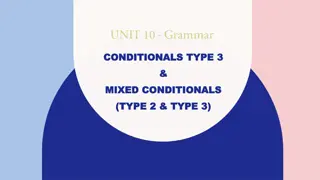Python Fundamentals - I/O, Conditionals, Booleans & Libraries
Python basics including I/O operations, conditional statements, boolean logic, and libraries. Understand how statements, compound statements, names, and execution of suites work in Python. Learn about whitespace importance and variable binding
Download Presentation

Please find below an Image/Link to download the presentation.
The content on the website is provided AS IS for your information and personal use only. It may not be sold, licensed, or shared on other websites without obtaining consent from the author.If you encounter any issues during the download, it is possible that the publisher has removed the file from their server.
You are allowed to download the files provided on this website for personal or commercial use, subject to the condition that they are used lawfully. All files are the property of their respective owners.
The content on the website is provided AS IS for your information and personal use only. It may not be sold, licensed, or shared on other websites without obtaining consent from the author.
E N D
Presentation Transcript
I/O, Conditionals, Booleans, & Libraries
Statements A statement is executed by the interpreter to perform an action. Some examples (details on these in future slides and lectures) Statement type Example name = 'sosuke' greeting = 'ahoy, ' + name Assignment statement def greet(name): return 'ahoy, ' + name Def statement Return statement return 'ahoy, ' + name
Compound statements A compound statement contains groups of other statements. <header>: <statement> <statement> ... # CLAUSE # SUITE <separating header>: <statement> <statement> ... # CLAUSE # SUITE The first header determines a statement's type, and the header of each clause controls the suite that follows.
Python and Whitespace In Python, whitespace matters! This is different than most other languages, especially the curly brace languages (C & C++ and their derivatives such as Java, C#, Javascript, etc.) Python uses newlines to signify the end of statements Python uses the indentation level to signify the contents of suites or blocks of code. Everything in a block of code must be at the same indentation level. It can be tabs or spaces but must be the same for any given suite no mixing and matching.
Execution of suites A suite is a sequence of statements. <header>: <statement> <statement> ... # SUITE <separating header>: <statement> <statement> ... # SUITE Execution rule for a sequence of statements: Execute the first statement Unless directed otherwise, execute the rest
Names A name can be bound to a value. One way to bind a name is with an assignment statement. The value can be any expression:
Using names A name can be referenced multiple times: x = 10 y = 3 result1 = x * y result2 = x + y A name that's bound to a data value is also known as a variable. Be aware that in Python, you can also bind names to existing functions: f = pow f(10, 2) #=> 100
Name rebinding A name can only be bound to a single value my_name = 'Pamela' my_name = my_name + 'ella' Will that code cause an error? If not, what will my_name store? It will not error (similar code in other languages might, however). The name my_name is now bound to the value 'Pamelaella'.
Getting User Input To allow the user to provide input to a program while it is running, we use the input() function Syntax: input([<prompt>]) This function returns a string containing whatever the user typed. If we provide a string as the prompt, that is printed out to the user We need to capture the output of the function in a variable nPeople = input("Enter the number of guests")
Converting Strings to Numbers If you have strings representing numbers, Python doesn't recognize them as numbers unless you convert them. This is done using the int()and float()functions integer_value = int('2') # converts '2' to 2 float_value = float('3.2') # converts '3.2' to 3.2 Note: if you try to call int() on a string representing a floating-point number, you will get an error
Writing to the screen To write something to the computer screen, we use the print() statement print("Hello world!") # Hello world! We can print as many different things in a single print statement as we would like. Just separate them by commas A space is printed in between each one n = 10 print("There are", n, "apples.") # There are 10 apples.
Formatting decimal numbers When you print floating point numbers, Python will print a number of decimal places that it thinks is appropriate, usually as many as possible. e = 2.718281828459045 print("e = ", e) # e = 2.718281828459045 Often you don't want that. You can specify the number of decimal places by using an f-string: e = 2.718281828459045 print(f"2 decimals: {e:.2f}") print(f"10 decimals: {e:.10f}") # 2 decimals: 2.72 # 10 decimals: 2.7182818285 We'll talk more about f-strings and their uses in a future lecture
Boolean Expressions A Boolean value is either True or False and is used frequently in computer programs. An expression can evaluate to a Boolean. Most Boolean expressions use either comparison or logical operators. An expression with a comparison operator: passed_class = grade > 65 An expression with a logical operator: wear_jacket = is_raining or is_windy
Comparison Operators Operator Meaning == != > >= < <= True expressions 32 == 32 Equality (is equal to) Inequality (is not equal to) 30 != 32 Greater than Greater than or equal Less than Less than or equal 60 > 32 60 >= 32, 32 >= 32 20 < 32 20 < 32, 32 <= 32 Common mistake: Do not confuse = (the assignment operator) with == (the equality operator).
Logical Operators Operator True Expressions Meaning Evaluates to True if both conditions are true. If one is False evaluates to False. Evaluates to True if either condition is true. Evaluates to False only if both are false. Evaluates to True if condition is false; evaluates to False if condition is true. and 4 > 0 and -2 < 0 or 4 > 2 or -2 < 0 not not (5 == 0)
Compound Booleans When combining multiple operators in a single expression, use parentheses to group: may_have_mobility_issues = (age >= 0 and age < 2) or age > 90 There is an order of operations to the evaluation of the Boolean operators, but it is always safer to include the parentheses.
Conditional Statements A conditional statement gives your code a way to execute a different suite of code statements based on whether certain conditions are true or false. if <condition>: <statement> <statement> ... A simple conditional: clothing = "shirt" if temperature < 32: clothing = "jacket"
Compound conditionals A conditional can include any number of elif statements to check other conditions. if <condition>: <statement> ... elif <condition>: <statement> ... elif <condition>: <statement> ... clothing = "shirt" if temperature < 0: clothing = "snowsuit" elif temperature < 32: clothing = "jacket"
The else statement A conditional can include an else clause to specify code to execute if no previous conditions are true. if <condition>: <statement> ... elif <condition>: <statement> ... else: <statement> ... if temperature < 0: clothing = "snowsuit" elif temperature < 32: clothing = "jacket" else: clothing = "shirt"
Conditional statements summary if num < 0: sign = "negative" elif num > 0: sign = "positive" else: sign = "neutral" Syntax tips: Always start with if clause. Zero or more elif clauses. Zero or one else clause, always at the end.
Execution of conditional statements Each clause is considered in order. Evaluate the header's expression. If it's true, execute the suite of statements underneath and skip the remaining clauses. Otherwise, continue to the next clause. num = 5 if num < 0: sign = "negative" elif num > 0: sign = "positive" else: sign = "neutral"
How Python reads a file When Python opens a file, it starts reading the file and executing all the statements inside it in order. But Python files can be opened in different ways: As a program As a module (more on modules later) In either case, all the statements are executed However, when opened as a program a special variable name, __name__ is assigned the value "__main__" This allows us to specify code that should only be run when invoked as a program
An example This is the starter code we give you for Homework 00 ## CONSTANTS SHOULD GO BELOW THIS COMMENT ## def main(): ## YOUR CODE SHOULD GO IN THIS FUNCTION ## pass if __name__ == "__main__": main() We'll talk more about how this can be helpful and useful, as well as the def statement syntax, later. For now, just remember to implement your code where the comment says to.
Opening and closing files To access files from our programs, we need to be able to open and close them To open a file: myFile = open(<filename>,<access mode>) <filename> is just the disk path to the file. If it is in the current directory, you can just specify the filename <access mode> let's you tell the computer how you're going to access the file, 'r' to read, 'w' to write (overwriting what is already there, and 'a' to append to an existing file. myFile = open('student_data.csv','r') To close a file we use the close() function myFile.close()
The with Statement If you don't like remembering to write the close() command, you can also use the with statement: with open(<filename>,<access mode>) as <name>: # code that uses the file <name> In this form, you put all the code that uses the file in the suite under the with statement as the header for the compound statement. Once the suite of commands is done executing, the file is automatically closed. If you need to use the file again later, you will need to reopen it. Or use the other form to keep it open until you are done (and then call close() ).
Reading text from files To read textual data from files you have several options Read in the entire file at once into a single string object: data = myFile.read() Read in all the lines in the file into a list of strings: data_lines = myFile.readlines() Read a single line: one_line = myFile.readline() If you read all the lines into a list, you can then loop over them with a for statement: for line in data_lines: # work with the line variable
Writing to files When writing to a file you have a couple of options: Write a single string as a single line: out_file.write(line) Write a collection of strings (like a list): myList = ['Line 1', 'Line 2', 'Line 3'] out_file.writelines(myList) Note: writelines() doesn't put newlines after each item, it just writes the items in the collection, it's up to you to add the newlines if they are not already part of the collection items being written
Libraries At the simplest level, libraries are just code that is external to your program that you want to use Code someone else wrote that does what you need Code you wrote at another time that you want to reuse Code you're writing now but it's too much to usably fit in a single file By putting code into libraries, you only need to include the parts that you are going to use instead of having all the code in a single file. In order to use the code in a library, we need to install and import it. There are three different ways to import code from a library
Installing libraries Python comes with a lot of useful libraries, but most libraries are not part of the standard Python distribution. We'll be using several libraries this semester that you will need to install as you work through the labs, homeworks, and projects When you want to install new libraries, you use the pip command in a terminal window pip install byuimage Sometimes this doesn't work, and you need to use the longer form: python m pip install byuimage This installs the library and then you can import it in your Python code import byuimage
Import the entire library Import the entire library import operator To use functions and object that are imported like this, we reference them using the name of the library, a period, and the name of the thing we want to use: sum = operator.add(3,7) You can bind the library name to something else if you want import operator as op sum = op.add(3,7) This is often done if the library name is long to save on typing Just be sure your short name makes sense and is easy to understand
Import all the names from a library The previous import method grabbed the entire library but kept the names separate from any names you defined in your program by requiring you to use the library name (or alias) when calling the functions If you don't want to have to use the library name each time, you can import this way from operator import * sum = add(3,7) This is only recommended for small libraries where you know all the names. If you import something this way, and it has the same name as something you created in your code, there will problems and the code might not do what you expect
Import specific items from a library When you only need a few items from the library, you can just import the specific items you need from operator import add, mul, sub The items are listed in a comma separated list and are added to your code without the library name at the beginning sum = add(3, 7) product = mul(2, 5) difference = sub(15, 2) This is probably the most common way to import functions or objects into your code



